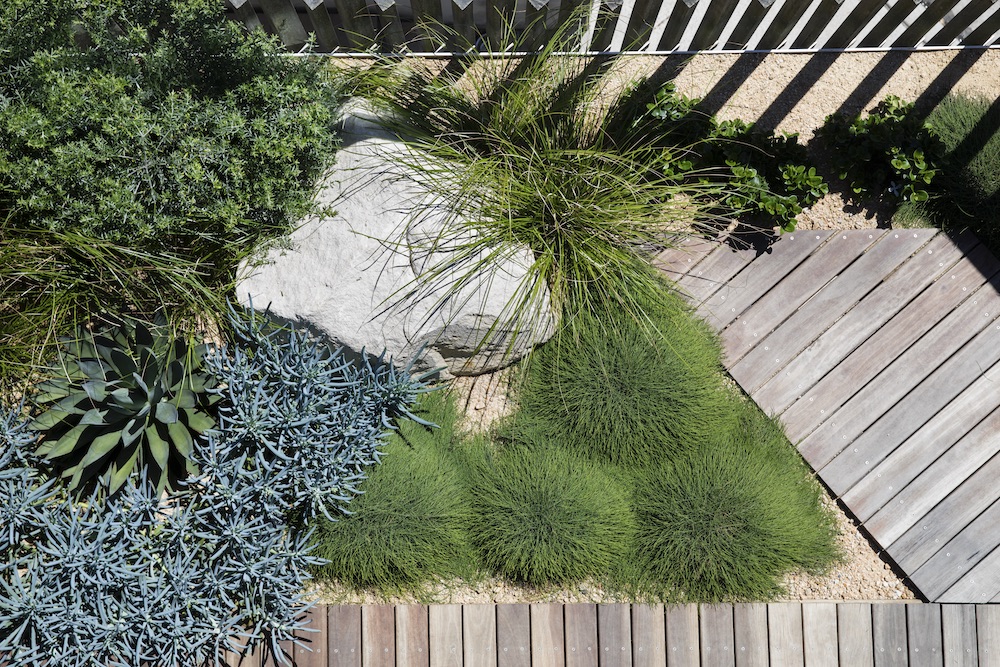As apartment living for Australian families reaches an unprecedented high, landscape design expert Matt Leacy explains how traditional backyard features can be transported to the roof with his tips for a green rooftop oasis.
Inner-city living is on the rise for Australian families, but just because you live in an apartment without a backyard, it doesn’t mean you have to give up all of the advantages that come with a domestic garden space, says Landart Landscapes’ Matt Leacy.
Maximise the land available and try to include a garden everywhere – even over structures, and create a green rooftop oasis to benefit not only health, lifestyle and property value, but the environment as well.
Matt outlines his top tips for creating a cost-efficient and sustainable green roof.
- Due Diligence
“Before getting too deep into the process of planning your rooftop garden, it’s best to first tick off the basics,” says Matt.
“That means engaging a structural engineer to check that the roof is properly intact and suitable for the type of rooftop space you’re planning to do.”
“This is particularly important for large-scale installations, especially if you’re considering big planters and additional rooftop features such as outdoor furnishings, outdoor kitchens and overhead structures, which can all be quite load-intensive on the roof,” Matt says. “Water and soil on their own are very weighty, so there may be only so much you can do.”
“A structural engineer will check the roof and advise on what can be done to convert, and to make it waterproof and suitable for proper drainage, as well as advising on the weight-loads the roof is able to support,” explains Matt.
“It’s also essential to check with your local Council to make sure your garden plans are compliant with state and local legislation and regulations, and to gain approvals if necessary,” adds Matt. “In most Australian areas, a green roof will require the lodgment of a development application.”
- What to Plant
“Just like you would if planning a backyard, think about the style you want your green roof to have, as well as your intended uses for it,” says Matt. “Considering these factors from the outset will help you plan and execute your rooftop haven much more effectively.”
“And, if you’re unsure or low on inspiration, it might be worth getting a professional landscape designer in to do the job,” adds Matt.
“In Australia, many roofs need to contend with extreme weather conditions year-round – blistering heat in summer, and lots of rain and wind in the cooler months,” says Matt.” As such, you’ll ideally want to work with plant species that are hardy and weather resistant, as well as suitable in size for the rooftop space. And if the rooftop is difficult to access, you’re best to choose plants that require minimum maintenance.”
“Plants that flourish in containers are often best for growing in artificial spaces like rooftops,” notes Matt.
“Succulents, grasses and coastal species such as Cassurina glauca and Carpobrotus are great groundcovers and spillover plants,” says Matt.
“Pennisetum, Lomandra and Poa look amazing as ornamental grasses, and will also work to soften the overall look of the space,” he adds.
“Ball-shaped and architectural plants can also help lift a rooftop space. Some great low-maintenance options include succulents like Agave, Kalanchoe and Crassula. These varieties can also handle dry conditions, and have limited root-systems, so can survive in shallow soil.”
“If you’ve got good rooftop access, you might consider growing a range of organic vegetables and herbs – and you’ll be able to switch them up depending on what’s in season,” says Matt.
“For easy-to-grow vegetables, consider the likes of kale, cherry tomatoes, iceberg lettuce, snow peas, spinach, and zucchini. For herbs, I recommend parsley, rosemary, thyme, oregano and mint

- Consider Astroturf
“Planting traditional grass lawn on a rooftop can be an expensive process, and will require quite a bit of maintenance over the long run, especially in the roof is highly exposed without much natural shade,” says Matt.
“A good alternative to the real thing can be AstroTurf, bringing with it a comparable look and feel to natural grass, but with far less watering and maintenance requirements,” explains Matt. “You also won’t need to cut the grass, and you can let pets and little ones play on it without bringing dirt, mud and grass back into the home.”
“And if you want to make it really fun, you might even consider installing a little putting green in the AstroTurf,” adds Matt.
“Having said all of that, if you can keep your grass real, then it’s always my first choice.”
- Maintenance Requirements
“Maintenance requirements for a green roof will vary depending on its type and size, as well as weather conditions and the plant varieties growing on it,” says Matt.
“There are similarities with ground-level gardening. You’ll need to weed unwanted plants – and it’s important to fertilise at least once a year because rooftop gardens get less natural nutrients than ground-based gardens,” notes Matt.
“In terms of watering, it will again depend partly on how much rain you get,” says Matt. “You don’t want to water too much as water is very heavy on the roof, but you also need to account for the fact that rooftop gardens are generally more exposed to heat and sun than ground-level gardens. If, for example, you have a massive heatwave in summer, you’re going to need to water much more regularly.”
“The best approach to watering is to monitor plants regularly and adapt your watering in line with weather conditions as they change,” says Matt. “Another good low-maintenance option is to install an irrigation system. The system can be programmed to suit the seasons, and tailored to your specific plants and how much water they need.”
- Rooftop features
“Just like a ground level-garden, you’ll get much more use out of your green rooftop space if you introduce features to make it more comfortable and inviting,” says Matt.
“You will need to consider the weight capacity of the roof as well as local building codes first, but there is a variety of outdoor features and design elements that can potentially be suitable for green roofs and enhance their overall appeal,” says Matt.
“These might come in the form of timber decking, paving or water features, through to dining tables, seating, outdoor kitchens and fire pits.”
“Wind and sun protection are also important considerations,” says Matt. “Shade sails, retractable awnings, canopies and big market umbrellas can all be great options – and then you’ve got more permanent options like outdoor pavilions, pergolas and gazebos at the other end of the spectrum.”























Add Comment